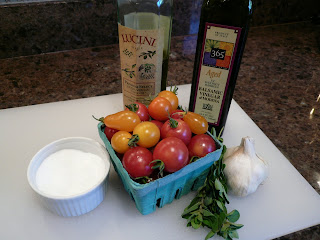
On a recent beautiful fall day I decided to make soup. I had a few things in my refrigerator: onions, celery, broccoli, some garlic. I decided on broccoli soup so I did what I always do and turned to Google. My experience with this approach hasn't always yielded the best recipes or results. During my search I found broccoli soup recipes with the bare minimum of ingredients (water, broccoli, salt) and others that included butter, flour, cream, potatoes, oatmeal and any other number of ingredients and still called itself broccoli soup.

Oh dear, I was going to have to go out on my own. Free-wheeling it isn't my style which isn't a helpful trait when it comes to creative endeavors. In all the crafts I've tried -- knitting, sewing, beading, card making -- I've always followed the directions pretty much to the letter. I'm a little more experienced in cooking so I feel pretty confident in straying somewhat off-recipe, but a recipe is firmly in front of me when I cook. Imagine my surprise when I had no recipe but managed to produce a rather fine broccoli soup. Better than fine. It's really, really good and it's low-fat and it's healthy. And it's easy and elegant and tastes luxurious.

I started by creating my soup "base" from which I would add or subtract flavorings to get to my final recipe. My base was simply onions, celery, garlic and broccoli simmered in vegetable stock until tender then pureed in our super-powerful Blendtec blender (love that thing!). I then ladled a tablespoon of this base into a small bowl and started adding things and tasting. Did my addition help? Is it better with more of it? Another tablespoon in a new bowl and another try. More salt? A little nutmeg? Some lemon or scallions? Some cream?
My final recipe tastes like the best Cream of Broccoli soup but doesn't use cream. I found any dairy (with the exception of the butter I used to wilt the onions and celery) just muted the deep and savory flavor of the broccoli and other vegetables. I got the texture I was looking for by pureeing the cooked vegetables until they were velvet on a spoon. I liked the back note of nutmeg and the lift of lemon zest, but didn't like the sourness of lemon juice. Salt, and it needed a good amount, black pepper for that pleasant back of throat bite, and I was done.

The key to this soup was to use as much broccoli as possible to thicken the soup without the need for other ingredients. Too much broccoli turns it into a pureed vegetable side dish, too little and it's thin and watery. You need as least as much broccoli as vegetable stock. One thing to emphasize is the need to puree it very well in order to get the creamy texture that cream or flour or some other thickener would normally provide. Our blender has a "Soups, Syrups, Fondues" button that starts slow then ratchets up to high and stays there for a full ninety seconds. Ninety seconds doesn't sound like a long time, but the noise it makes will chase you out of the kitchen. Time yourself, and if your blender isn't super powerful, go a full two minutes or longer. Also, don't fill the blender more than half full and remove the center of the lid and cover with a kitchen towel to allow the steam to escape when you start blending. Trust me on this.
No-Cream Broccoli Soup
serves 4
5 to 6 cups broccoli florets (from 2 large heads of broccoli)
1 medium yellow onion, diced
2 stalks celery, diced
3 cloves garlic, lightly crushed
1 tablespoon butter (you could easily substitute olive oil)
4 cups (one 32 oz. container) vegetable stock (Wolfgang Puck brand recommended)
1 teaspoon kosher salt (or to taste)
1/2 teaspoon pepper
1/4 teaspoon ground nutmeg
1/2 teaspoon lemon zest
1. Melt butter in a large pot over medium heat. Add the onion and celery, cover and cook over medium to medium low heat until the onions and celery are tender, stirring occasionally. You don't want to brown the vegetables, just wilt them.
2. Add the garlic, vegetable stock and broccoli. Bring to a boil then reduce the heat, cover, and let simmer for 15 or 20 minutes until the broccoli is very tender. You'll know you're there when a knife can run through the broccoli with no resistance.
3. Ladle the hot broth and vegetables into a blender and puree until very smooth. Do this in batches to avoid over-filling your blender. The puree needs to be absolutely smooth to get the creamy texture.
4. Return the puree to the soup pot, add salt, pepper, nutmeg and lemon zest. Bring back to a simmer for about 5 minutes to allow the flavors to blend. I liked this best served warm, not super hot, so take it off heat for a few minutes before serving.














